Business Report on Tesco Plc: Market Analysis and Strategy
VerifiedAdded on 2023/01/07
|11
|3358
|98
Report
AI Summary
This business report offers a thorough analysis of Tesco Plc, a leading UK-based retail organization. It begins by evaluating the type, size, and scope of Tesco, highlighting its public limited company structure, large multinational size, and extensive global operations. The report then explores the interrelationship of various business functions within Tesco's organizational structure, emphasizing the importance of effective coordination. A significant portion of the report is dedicated to internal and external influences on Tesco's business operations, utilizing both SWOT and PESTLE analyses to assess strengths, weaknesses, opportunities, threats, and the impact of political, economic, social, technological, legal, and environmental factors. The report also examines the influence of globalization on Tesco's strategic decision-making processes. Overall, the report provides a comprehensive overview of Tesco Plc's business environment, strategies, and challenges, offering insights into its operations and market position.
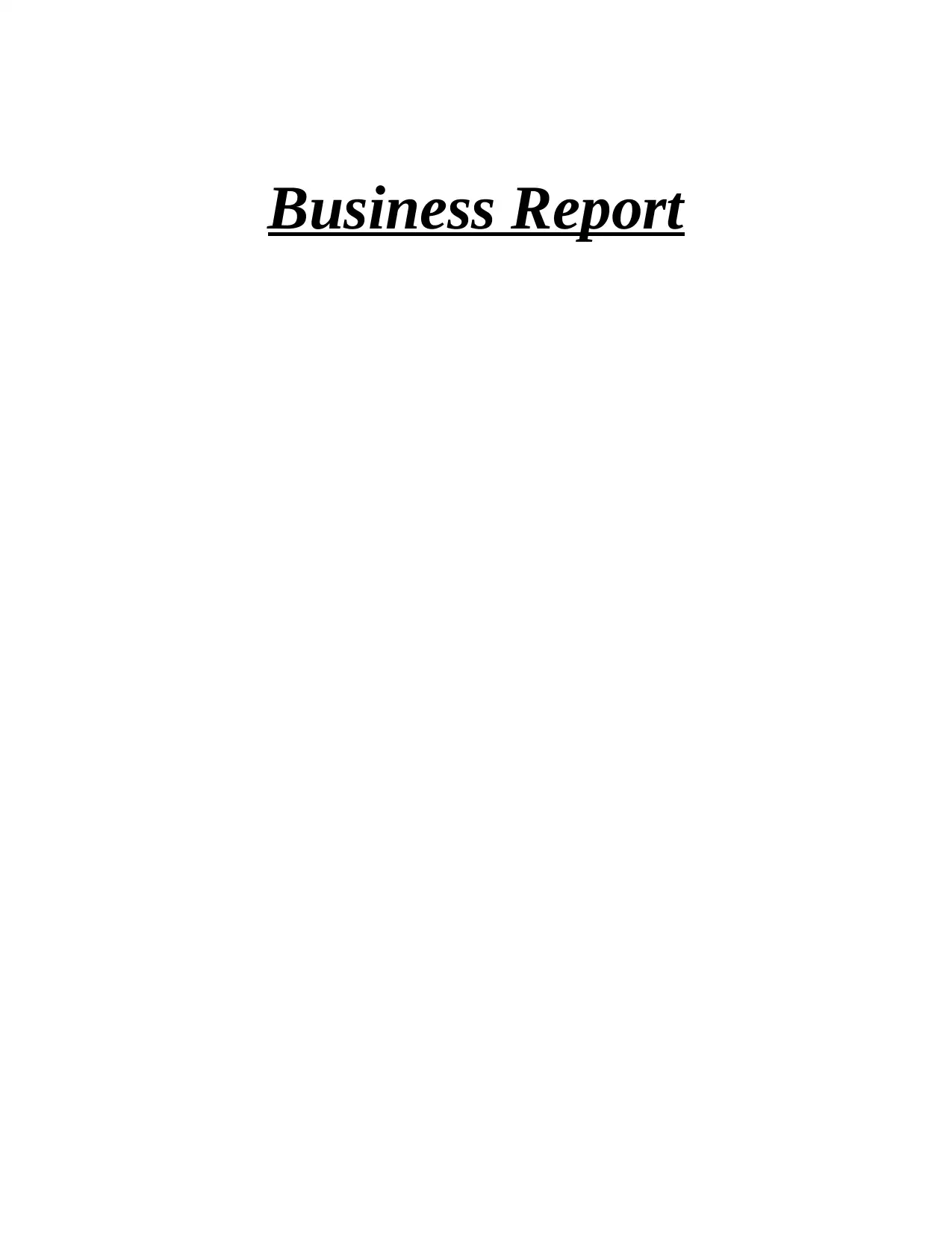
Business Report
Paraphrase This Document
Need a fresh take? Get an instant paraphrase of this document with our AI Paraphraser
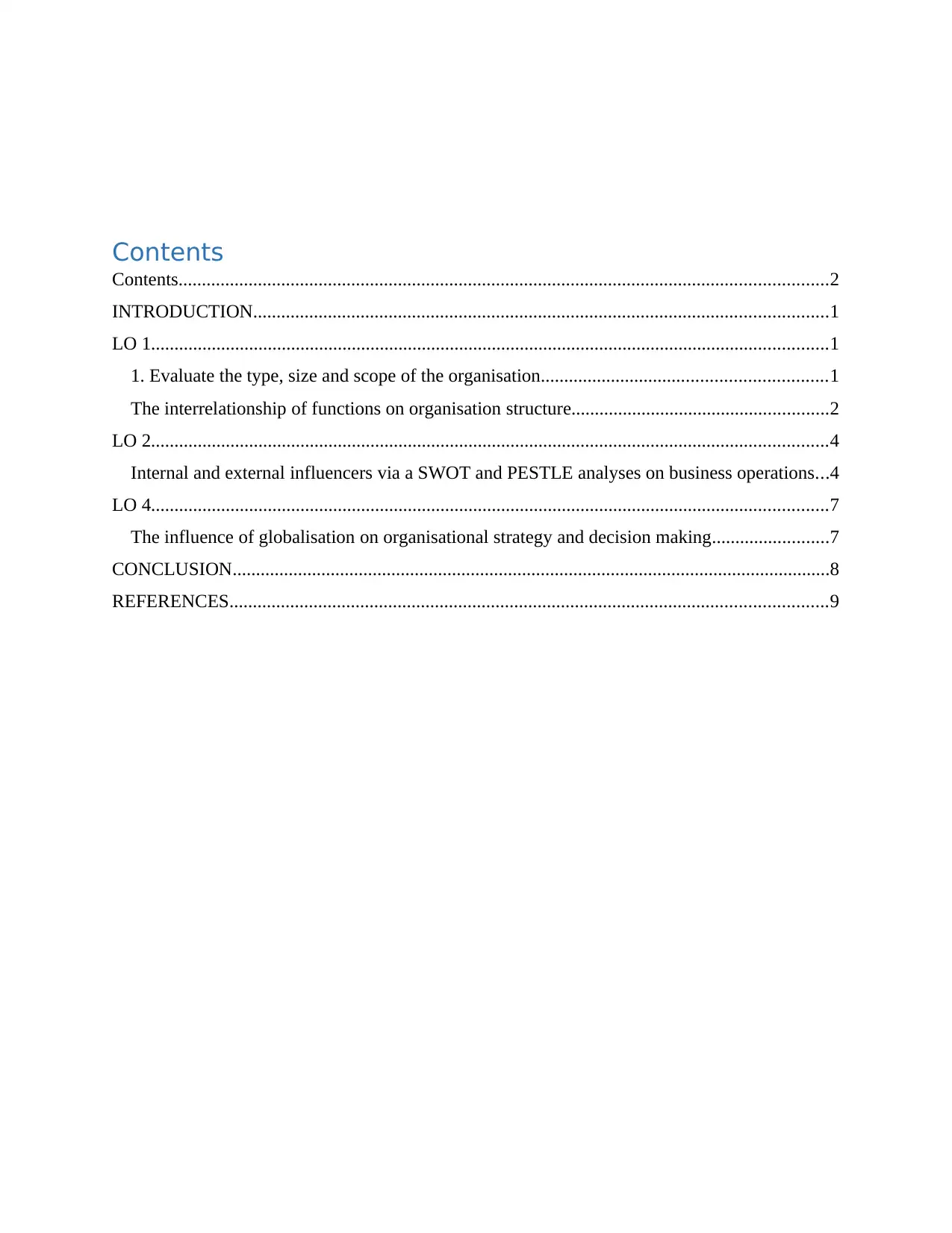
Contents
Contents...........................................................................................................................................2
INTRODUCTION...........................................................................................................................1
LO 1.................................................................................................................................................1
1. Evaluate the type, size and scope of the organisation.............................................................1
The interrelationship of functions on organisation structure.......................................................2
LO 2.................................................................................................................................................4
Internal and external influencers via a SWOT and PESTLE analyses on business operations...4
LO 4.................................................................................................................................................7
The influence of globalisation on organisational strategy and decision making.........................7
CONCLUSION................................................................................................................................8
REFERENCES................................................................................................................................9
Contents...........................................................................................................................................2
INTRODUCTION...........................................................................................................................1
LO 1.................................................................................................................................................1
1. Evaluate the type, size and scope of the organisation.............................................................1
The interrelationship of functions on organisation structure.......................................................2
LO 2.................................................................................................................................................4
Internal and external influencers via a SWOT and PESTLE analyses on business operations...4
LO 4.................................................................................................................................................7
The influence of globalisation on organisational strategy and decision making.........................7
CONCLUSION................................................................................................................................8
REFERENCES................................................................................................................................9
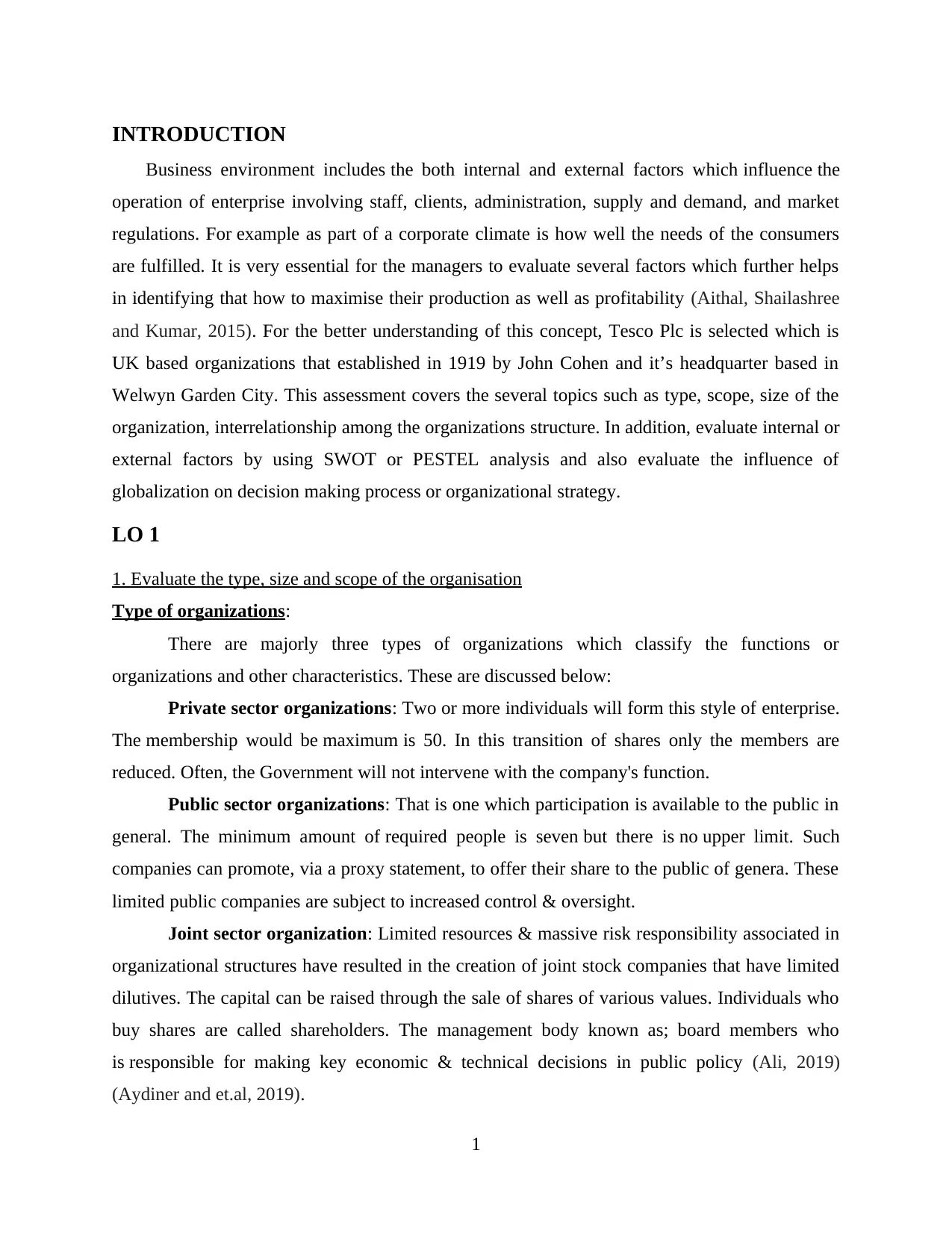
INTRODUCTION
Business environment includes the both internal and external factors which influence the
operation of enterprise involving staff, clients, administration, supply and demand, and market
regulations. For example as part of a corporate climate is how well the needs of the consumers
are fulfilled. It is very essential for the managers to evaluate several factors which further helps
in identifying that how to maximise their production as well as profitability (Aithal, Shailashree
and Kumar, 2015). For the better understanding of this concept, Tesco Plc is selected which is
UK based organizations that established in 1919 by John Cohen and it’s headquarter based in
Welwyn Garden City. This assessment covers the several topics such as type, scope, size of the
organization, interrelationship among the organizations structure. In addition, evaluate internal or
external factors by using SWOT or PESTEL analysis and also evaluate the influence of
globalization on decision making process or organizational strategy.
LO 1
1. Evaluate the type, size and scope of the organisation
Type of organizations:
There are majorly three types of organizations which classify the functions or
organizations and other characteristics. These are discussed below:
Private sector organizations: Two or more individuals will form this style of enterprise.
The membership would be maximum is 50. In this transition of shares only the members are
reduced. Often, the Government will not intervene with the company's function.
Public sector organizations: That is one which participation is available to the public in
general. The minimum amount of required people is seven but there is no upper limit. Such
companies can promote, via a proxy statement, to offer their share to the public of genera. These
limited public companies are subject to increased control & oversight.
Joint sector organization: Limited resources & massive risk responsibility associated in
organizational structures have resulted in the creation of joint stock companies that have limited
dilutives. The capital can be raised through the sale of shares of various values. Individuals who
buy shares are called shareholders. The management body known as; board members who
is responsible for making key economic & technical decisions in public policy (Ali, 2019)
(Aydiner and et.al, 2019).
1
Business environment includes the both internal and external factors which influence the
operation of enterprise involving staff, clients, administration, supply and demand, and market
regulations. For example as part of a corporate climate is how well the needs of the consumers
are fulfilled. It is very essential for the managers to evaluate several factors which further helps
in identifying that how to maximise their production as well as profitability (Aithal, Shailashree
and Kumar, 2015). For the better understanding of this concept, Tesco Plc is selected which is
UK based organizations that established in 1919 by John Cohen and it’s headquarter based in
Welwyn Garden City. This assessment covers the several topics such as type, scope, size of the
organization, interrelationship among the organizations structure. In addition, evaluate internal or
external factors by using SWOT or PESTEL analysis and also evaluate the influence of
globalization on decision making process or organizational strategy.
LO 1
1. Evaluate the type, size and scope of the organisation
Type of organizations:
There are majorly three types of organizations which classify the functions or
organizations and other characteristics. These are discussed below:
Private sector organizations: Two or more individuals will form this style of enterprise.
The membership would be maximum is 50. In this transition of shares only the members are
reduced. Often, the Government will not intervene with the company's function.
Public sector organizations: That is one which participation is available to the public in
general. The minimum amount of required people is seven but there is no upper limit. Such
companies can promote, via a proxy statement, to offer their share to the public of genera. These
limited public companies are subject to increased control & oversight.
Joint sector organization: Limited resources & massive risk responsibility associated in
organizational structures have resulted in the creation of joint stock companies that have limited
dilutives. The capital can be raised through the sale of shares of various values. Individuals who
buy shares are called shareholders. The management body known as; board members who
is responsible for making key economic & technical decisions in public policy (Ali, 2019)
(Aydiner and et.al, 2019).
1
⊘ This is a preview!⊘
Do you want full access?
Subscribe today to unlock all pages.

Trusted by 1+ million students worldwide
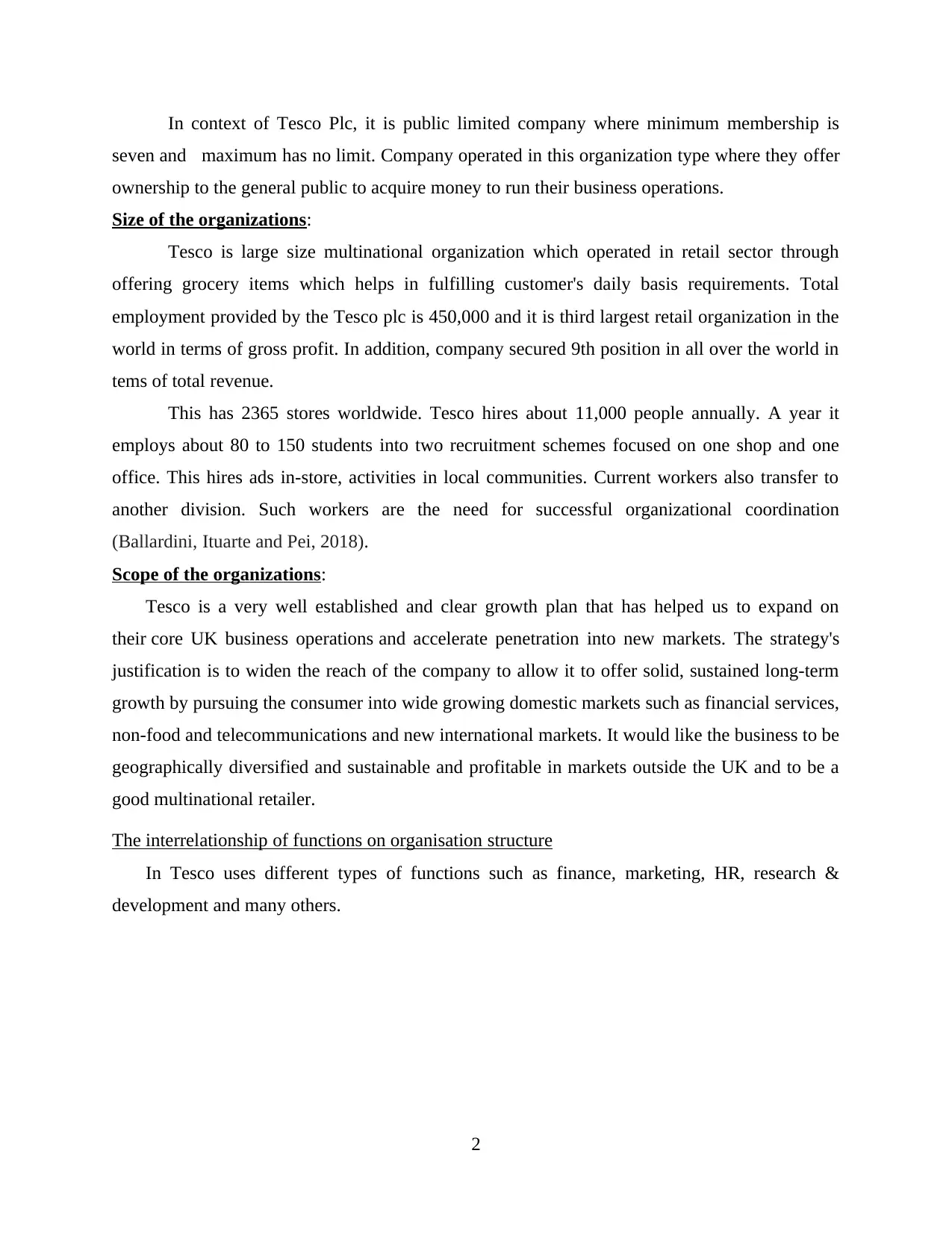
In context of Tesco Plc, it is public limited company where minimum membership is
seven and maximum has no limit. Company operated in this organization type where they offer
ownership to the general public to acquire money to run their business operations.
Size of the organizations:
Tesco is large size multinational organization which operated in retail sector through
offering grocery items which helps in fulfilling customer's daily basis requirements. Total
employment provided by the Tesco plc is 450,000 and it is third largest retail organization in the
world in terms of gross profit. In addition, company secured 9th position in all over the world in
tems of total revenue.
This has 2365 stores worldwide. Tesco hires about 11,000 people annually. A year it
employs about 80 to 150 students into two recruitment schemes focused on one shop and one
office. This hires ads in-store, activities in local communities. Current workers also transfer to
another division. Such workers are the need for successful organizational coordination
(Ballardini, Ituarte and Pei, 2018).
Scope of the organizations:
Tesco is a very well established and clear growth plan that has helped us to expand on
their core UK business operations and accelerate penetration into new markets. The strategy's
justification is to widen the reach of the company to allow it to offer solid, sustained long-term
growth by pursuing the consumer into wide growing domestic markets such as financial services,
non-food and telecommunications and new international markets. It would like the business to be
geographically diversified and sustainable and profitable in markets outside the UK and to be a
good multinational retailer.
The interrelationship of functions on organisation structure
In Tesco uses different types of functions such as finance, marketing, HR, research &
development and many others.
2
seven and maximum has no limit. Company operated in this organization type where they offer
ownership to the general public to acquire money to run their business operations.
Size of the organizations:
Tesco is large size multinational organization which operated in retail sector through
offering grocery items which helps in fulfilling customer's daily basis requirements. Total
employment provided by the Tesco plc is 450,000 and it is third largest retail organization in the
world in terms of gross profit. In addition, company secured 9th position in all over the world in
tems of total revenue.
This has 2365 stores worldwide. Tesco hires about 11,000 people annually. A year it
employs about 80 to 150 students into two recruitment schemes focused on one shop and one
office. This hires ads in-store, activities in local communities. Current workers also transfer to
another division. Such workers are the need for successful organizational coordination
(Ballardini, Ituarte and Pei, 2018).
Scope of the organizations:
Tesco is a very well established and clear growth plan that has helped us to expand on
their core UK business operations and accelerate penetration into new markets. The strategy's
justification is to widen the reach of the company to allow it to offer solid, sustained long-term
growth by pursuing the consumer into wide growing domestic markets such as financial services,
non-food and telecommunications and new international markets. It would like the business to be
geographically diversified and sustainable and profitable in markets outside the UK and to be a
good multinational retailer.
The interrelationship of functions on organisation structure
In Tesco uses different types of functions such as finance, marketing, HR, research &
development and many others.
2
Paraphrase This Document
Need a fresh take? Get an instant paraphrase of this document with our AI Paraphraser
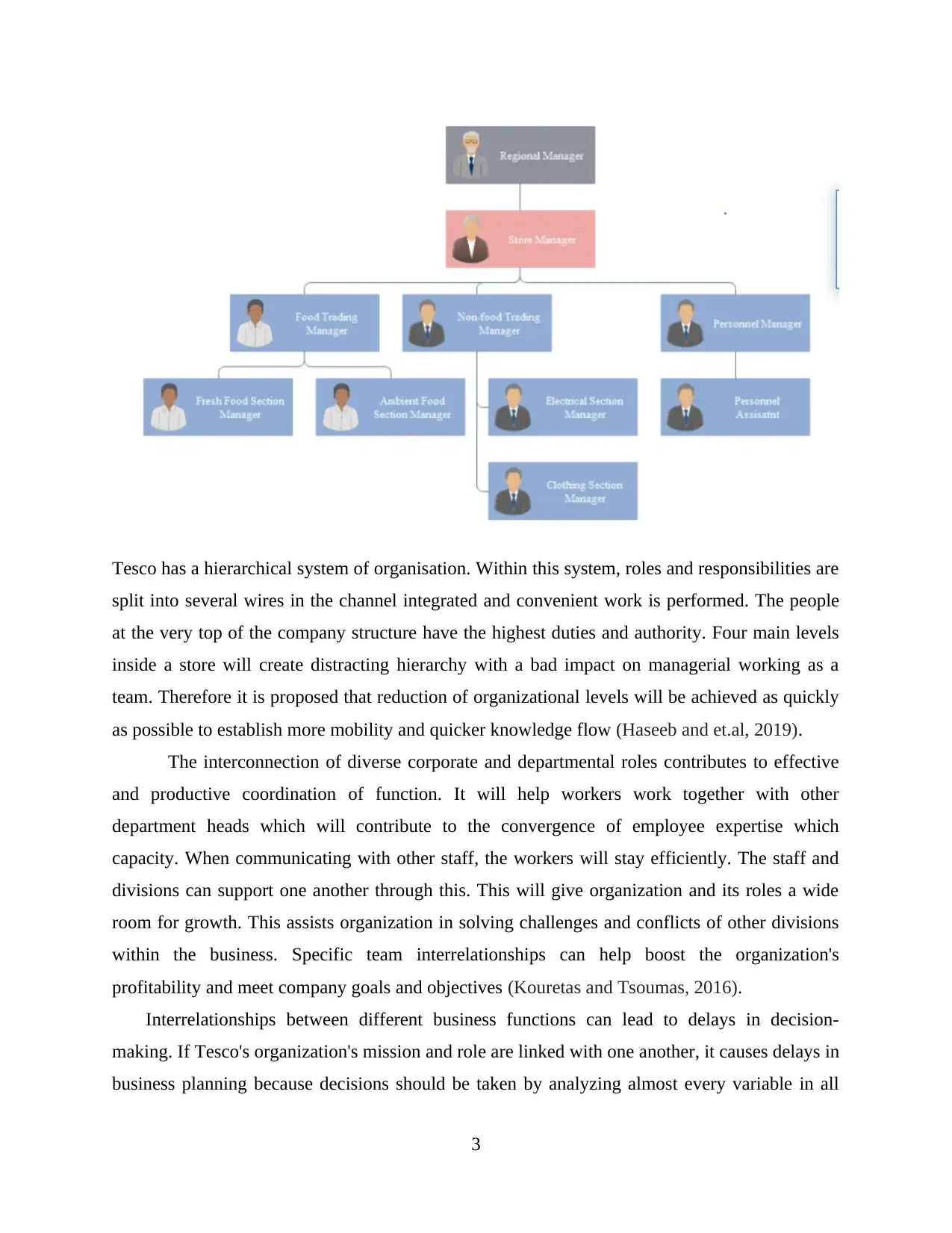
Tesco has a hierarchical system of organisation. Within this system, roles and responsibilities are
split into several wires in the channel integrated and convenient work is performed. The people
at the very top of the company structure have the highest duties and authority. Four main levels
inside a store will create distracting hierarchy with a bad impact on managerial working as a
team. Therefore it is proposed that reduction of organizational levels will be achieved as quickly
as possible to establish more mobility and quicker knowledge flow (Haseeb and et.al, 2019).
The interconnection of diverse corporate and departmental roles contributes to effective
and productive coordination of function. It will help workers work together with other
department heads which will contribute to the convergence of employee expertise which
capacity. When communicating with other staff, the workers will stay efficiently. The staff and
divisions can support one another through this. This will give organization and its roles a wide
room for growth. This assists organization in solving challenges and conflicts of other divisions
within the business. Specific team interrelationships can help boost the organization's
profitability and meet company goals and objectives (Kouretas and Tsoumas, 2016).
Interrelationships between different business functions can lead to delays in decision-
making. If Tesco's organization's mission and role are linked with one another, it causes delays in
business planning because decisions should be taken by analyzing almost every variable in all
3
split into several wires in the channel integrated and convenient work is performed. The people
at the very top of the company structure have the highest duties and authority. Four main levels
inside a store will create distracting hierarchy with a bad impact on managerial working as a
team. Therefore it is proposed that reduction of organizational levels will be achieved as quickly
as possible to establish more mobility and quicker knowledge flow (Haseeb and et.al, 2019).
The interconnection of diverse corporate and departmental roles contributes to effective
and productive coordination of function. It will help workers work together with other
department heads which will contribute to the convergence of employee expertise which
capacity. When communicating with other staff, the workers will stay efficiently. The staff and
divisions can support one another through this. This will give organization and its roles a wide
room for growth. This assists organization in solving challenges and conflicts of other divisions
within the business. Specific team interrelationships can help boost the organization's
profitability and meet company goals and objectives (Kouretas and Tsoumas, 2016).
Interrelationships between different business functions can lead to delays in decision-
making. If Tesco's organization's mission and role are linked with one another, it causes delays in
business planning because decisions should be taken by analyzing almost every variable in all
3
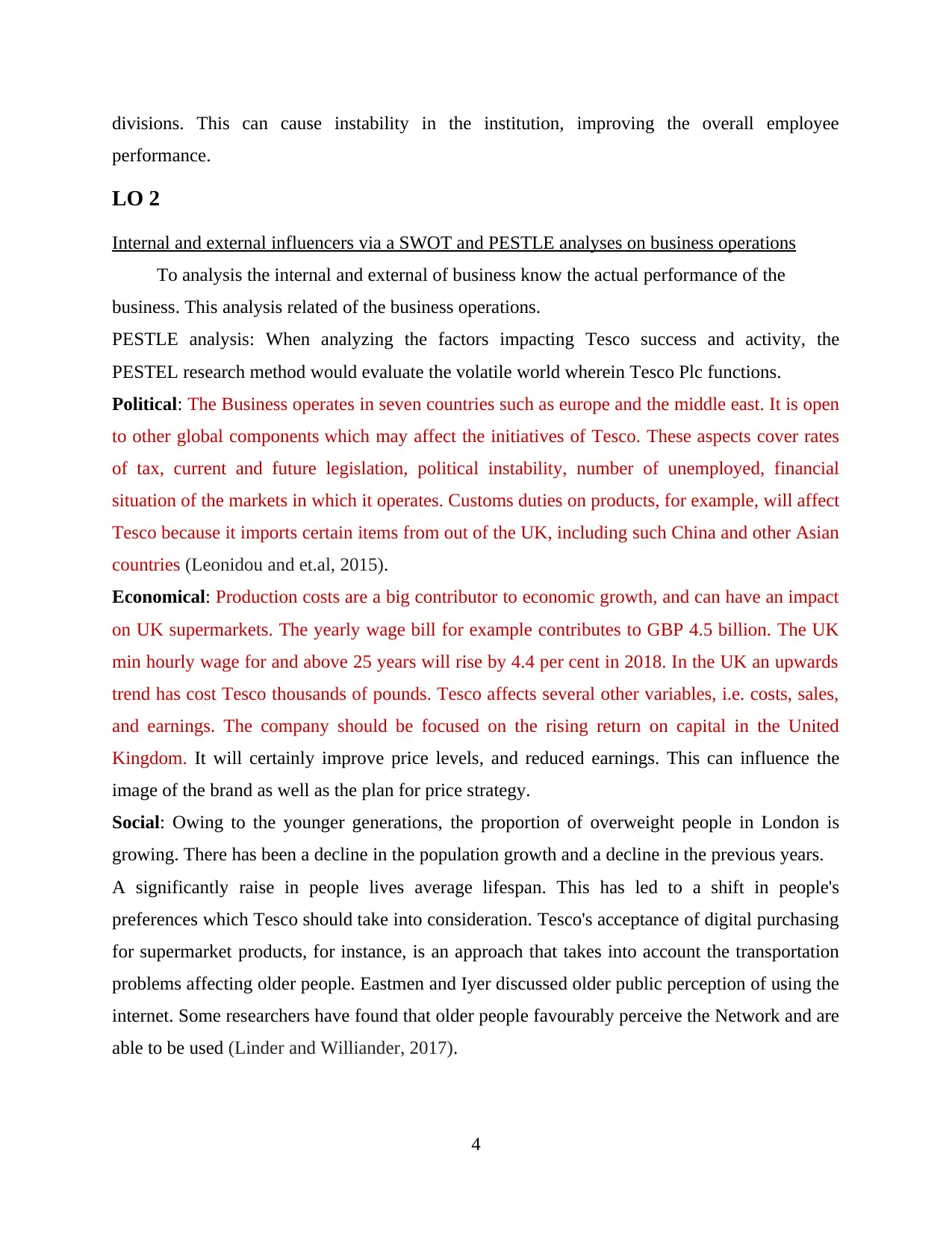
divisions. This can cause instability in the institution, improving the overall employee
performance.
LO 2
Internal and external influencers via a SWOT and PESTLE analyses on business operations
To analysis the internal and external of business know the actual performance of the
business. This analysis related of the business operations.
PESTLE analysis: When analyzing the factors impacting Tesco success and activity, the
PESTEL research method would evaluate the volatile world wherein Tesco Plc functions.
Political: The Business operates in seven countries such as europe and the middle east. It is open
to other global components which may affect the initiatives of Tesco. These aspects cover rates
of tax, current and future legislation, political instability, number of unemployed, financial
situation of the markets in which it operates. Customs duties on products, for example, will affect
Tesco because it imports certain items from out of the UK, including such China and other Asian
countries (Leonidou and et.al, 2015).
Economical: Production costs are a big contributor to economic growth, and can have an impact
on UK supermarkets. The yearly wage bill for example contributes to GBP 4.5 billion. The UK
min hourly wage for and above 25 years will rise by 4.4 per cent in 2018. In the UK an upwards
trend has cost Tesco thousands of pounds. Tesco affects several other variables, i.e. costs, sales,
and earnings. The company should be focused on the rising return on capital in the United
Kingdom. It will certainly improve price levels, and reduced earnings. This can influence the
image of the brand as well as the plan for price strategy.
Social: Owing to the younger generations, the proportion of overweight people in London is
growing. There has been a decline in the population growth and a decline in the previous years.
A significantly raise in people lives average lifespan. This has led to a shift in people's
preferences which Tesco should take into consideration. Tesco's acceptance of digital purchasing
for supermarket products, for instance, is an approach that takes into account the transportation
problems affecting older people. Eastmen and Iyer discussed older public perception of using the
internet. Some researchers have found that older people favourably perceive the Network and are
able to be used (Linder and Williander, 2017).
4
performance.
LO 2
Internal and external influencers via a SWOT and PESTLE analyses on business operations
To analysis the internal and external of business know the actual performance of the
business. This analysis related of the business operations.
PESTLE analysis: When analyzing the factors impacting Tesco success and activity, the
PESTEL research method would evaluate the volatile world wherein Tesco Plc functions.
Political: The Business operates in seven countries such as europe and the middle east. It is open
to other global components which may affect the initiatives of Tesco. These aspects cover rates
of tax, current and future legislation, political instability, number of unemployed, financial
situation of the markets in which it operates. Customs duties on products, for example, will affect
Tesco because it imports certain items from out of the UK, including such China and other Asian
countries (Leonidou and et.al, 2015).
Economical: Production costs are a big contributor to economic growth, and can have an impact
on UK supermarkets. The yearly wage bill for example contributes to GBP 4.5 billion. The UK
min hourly wage for and above 25 years will rise by 4.4 per cent in 2018. In the UK an upwards
trend has cost Tesco thousands of pounds. Tesco affects several other variables, i.e. costs, sales,
and earnings. The company should be focused on the rising return on capital in the United
Kingdom. It will certainly improve price levels, and reduced earnings. This can influence the
image of the brand as well as the plan for price strategy.
Social: Owing to the younger generations, the proportion of overweight people in London is
growing. There has been a decline in the population growth and a decline in the previous years.
A significantly raise in people lives average lifespan. This has led to a shift in people's
preferences which Tesco should take into consideration. Tesco's acceptance of digital purchasing
for supermarket products, for instance, is an approach that takes into account the transportation
problems affecting older people. Eastmen and Iyer discussed older public perception of using the
internet. Some researchers have found that older people favourably perceive the Network and are
able to be used (Linder and Williander, 2017).
4
⊘ This is a preview!⊘
Do you want full access?
Subscribe today to unlock all pages.

Trusted by 1+ million students worldwide
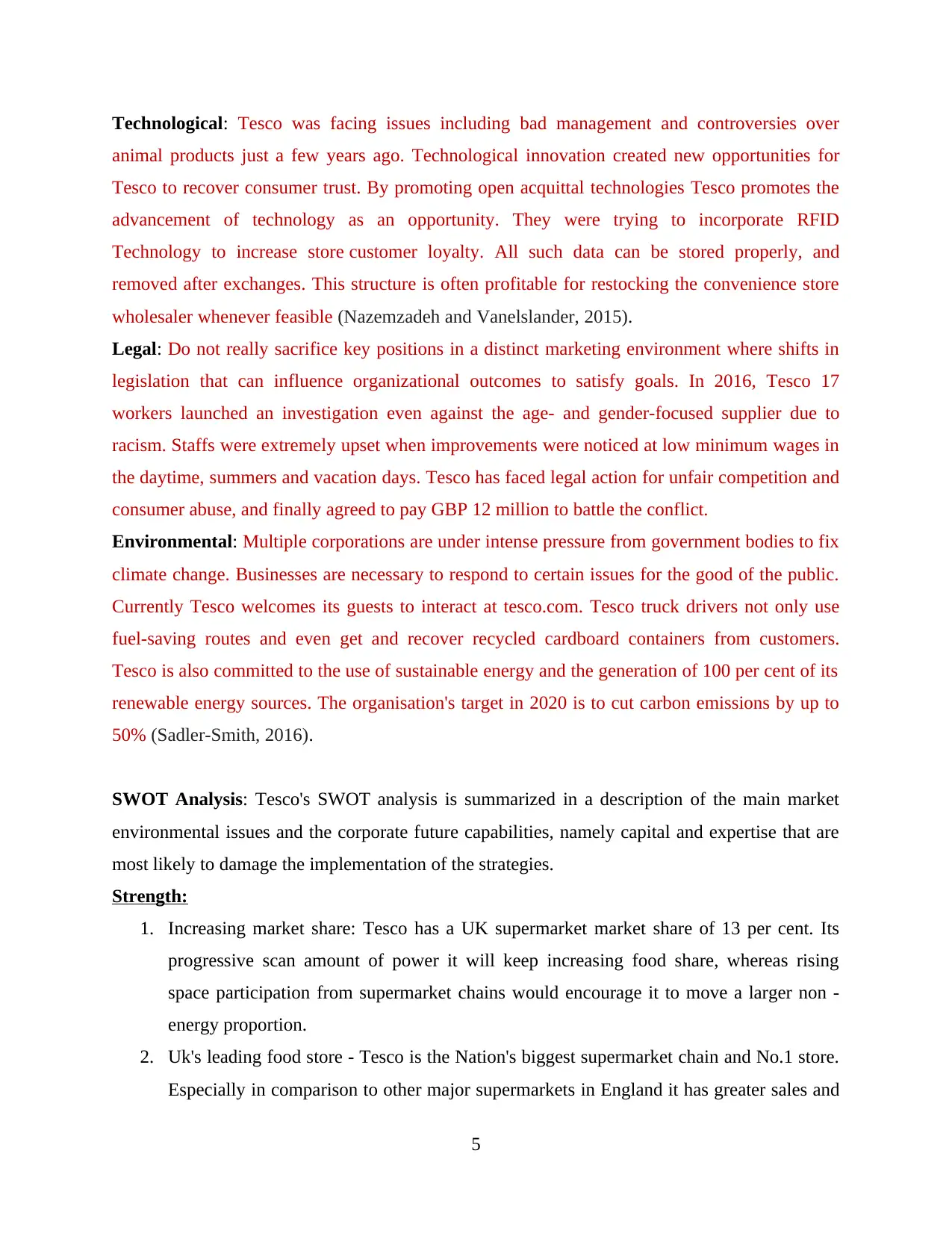
Technological: Tesco was facing issues including bad management and controversies over
animal products just a few years ago. Technological innovation created new opportunities for
Tesco to recover consumer trust. By promoting open acquittal technologies Tesco promotes the
advancement of technology as an opportunity. They were trying to incorporate RFID
Technology to increase store customer loyalty. All such data can be stored properly, and
removed after exchanges. This structure is often profitable for restocking the convenience store
wholesaler whenever feasible (Nazemzadeh and Vanelslander, 2015).
Legal: Do not really sacrifice key positions in a distinct marketing environment where shifts in
legislation that can influence organizational outcomes to satisfy goals. In 2016, Tesco 17
workers launched an investigation even against the age- and gender-focused supplier due to
racism. Staffs were extremely upset when improvements were noticed at low minimum wages in
the daytime, summers and vacation days. Tesco has faced legal action for unfair competition and
consumer abuse, and finally agreed to pay GBP 12 million to battle the conflict.
Environmental: Multiple corporations are under intense pressure from government bodies to fix
climate change. Businesses are necessary to respond to certain issues for the good of the public.
Currently Tesco welcomes its guests to interact at tesco.com. Tesco truck drivers not only use
fuel-saving routes and even get and recover recycled cardboard containers from customers.
Tesco is also committed to the use of sustainable energy and the generation of 100 per cent of its
renewable energy sources. The organisation's target in 2020 is to cut carbon emissions by up to
50% (Sadler-Smith, 2016).
SWOT Analysis: Tesco's SWOT analysis is summarized in a description of the main market
environmental issues and the corporate future capabilities, namely capital and expertise that are
most likely to damage the implementation of the strategies.
Strength:
1. Increasing market share: Tesco has a UK supermarket market share of 13 per cent. Its
progressive scan amount of power it will keep increasing food share, whereas rising
space participation from supermarket chains would encourage it to move a larger non -
energy proportion.
2. Uk's leading food store - Tesco is the Nation's biggest supermarket chain and No.1 store.
Especially in comparison to other major supermarkets in England it has greater sales and
5
animal products just a few years ago. Technological innovation created new opportunities for
Tesco to recover consumer trust. By promoting open acquittal technologies Tesco promotes the
advancement of technology as an opportunity. They were trying to incorporate RFID
Technology to increase store customer loyalty. All such data can be stored properly, and
removed after exchanges. This structure is often profitable for restocking the convenience store
wholesaler whenever feasible (Nazemzadeh and Vanelslander, 2015).
Legal: Do not really sacrifice key positions in a distinct marketing environment where shifts in
legislation that can influence organizational outcomes to satisfy goals. In 2016, Tesco 17
workers launched an investigation even against the age- and gender-focused supplier due to
racism. Staffs were extremely upset when improvements were noticed at low minimum wages in
the daytime, summers and vacation days. Tesco has faced legal action for unfair competition and
consumer abuse, and finally agreed to pay GBP 12 million to battle the conflict.
Environmental: Multiple corporations are under intense pressure from government bodies to fix
climate change. Businesses are necessary to respond to certain issues for the good of the public.
Currently Tesco welcomes its guests to interact at tesco.com. Tesco truck drivers not only use
fuel-saving routes and even get and recover recycled cardboard containers from customers.
Tesco is also committed to the use of sustainable energy and the generation of 100 per cent of its
renewable energy sources. The organisation's target in 2020 is to cut carbon emissions by up to
50% (Sadler-Smith, 2016).
SWOT Analysis: Tesco's SWOT analysis is summarized in a description of the main market
environmental issues and the corporate future capabilities, namely capital and expertise that are
most likely to damage the implementation of the strategies.
Strength:
1. Increasing market share: Tesco has a UK supermarket market share of 13 per cent. Its
progressive scan amount of power it will keep increasing food share, whereas rising
space participation from supermarket chains would encourage it to move a larger non -
energy proportion.
2. Uk's leading food store - Tesco is the Nation's biggest supermarket chain and No.1 store.
Especially in comparison to other major supermarkets in England it has greater sales and
5
Paraphrase This Document
Need a fresh take? Get an instant paraphrase of this document with our AI Paraphraser
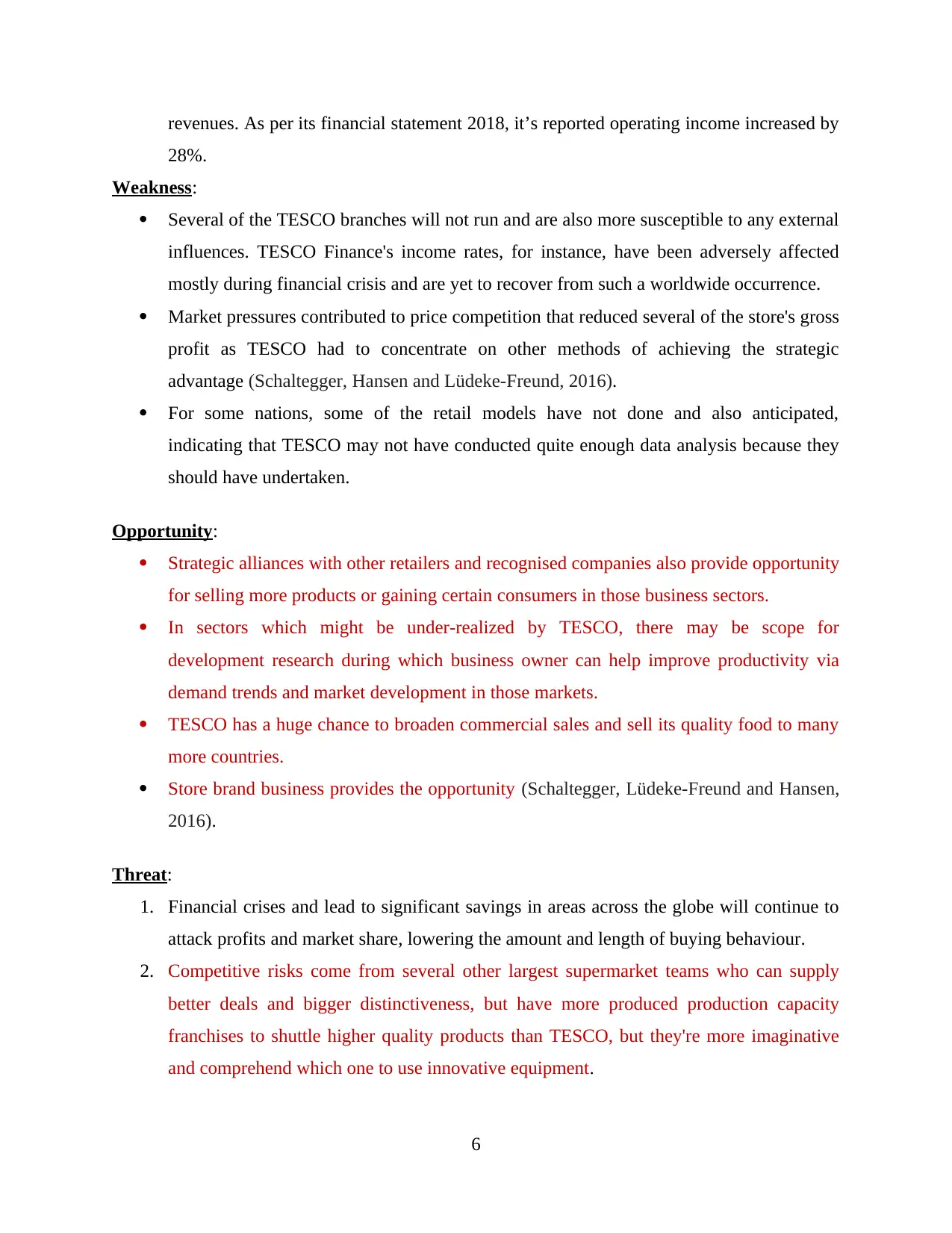
revenues. As per its financial statement 2018, it’s reported operating income increased by
28%.
Weakness:
Several of the TESCO branches will not run and are also more susceptible to any external
influences. TESCO Finance's income rates, for instance, have been adversely affected
mostly during financial crisis and are yet to recover from such a worldwide occurrence.
Market pressures contributed to price competition that reduced several of the store's gross
profit as TESCO had to concentrate on other methods of achieving the strategic
advantage (Schaltegger, Hansen and Lüdeke-Freund, 2016).
For some nations, some of the retail models have not done and also anticipated,
indicating that TESCO may not have conducted quite enough data analysis because they
should have undertaken.
Opportunity:
Strategic alliances with other retailers and recognised companies also provide opportunity
for selling more products or gaining certain consumers in those business sectors.
In sectors which might be under-realized by TESCO, there may be scope for
development research during which business owner can help improve productivity via
demand trends and market development in those markets.
TESCO has a huge chance to broaden commercial sales and sell its quality food to many
more countries.
Store brand business provides the opportunity (Schaltegger, Lüdeke-Freund and Hansen,
2016).
Threat:
1. Financial crises and lead to significant savings in areas across the globe will continue to
attack profits and market share, lowering the amount and length of buying behaviour.
2. Competitive risks come from several other largest supermarket teams who can supply
better deals and bigger distinctiveness, but have more produced production capacity
franchises to shuttle higher quality products than TESCO, but they're more imaginative
and comprehend which one to use innovative equipment.
6
28%.
Weakness:
Several of the TESCO branches will not run and are also more susceptible to any external
influences. TESCO Finance's income rates, for instance, have been adversely affected
mostly during financial crisis and are yet to recover from such a worldwide occurrence.
Market pressures contributed to price competition that reduced several of the store's gross
profit as TESCO had to concentrate on other methods of achieving the strategic
advantage (Schaltegger, Hansen and Lüdeke-Freund, 2016).
For some nations, some of the retail models have not done and also anticipated,
indicating that TESCO may not have conducted quite enough data analysis because they
should have undertaken.
Opportunity:
Strategic alliances with other retailers and recognised companies also provide opportunity
for selling more products or gaining certain consumers in those business sectors.
In sectors which might be under-realized by TESCO, there may be scope for
development research during which business owner can help improve productivity via
demand trends and market development in those markets.
TESCO has a huge chance to broaden commercial sales and sell its quality food to many
more countries.
Store brand business provides the opportunity (Schaltegger, Lüdeke-Freund and Hansen,
2016).
Threat:
1. Financial crises and lead to significant savings in areas across the globe will continue to
attack profits and market share, lowering the amount and length of buying behaviour.
2. Competitive risks come from several other largest supermarket teams who can supply
better deals and bigger distinctiveness, but have more produced production capacity
franchises to shuttle higher quality products than TESCO, but they're more imaginative
and comprehend which one to use innovative equipment.
6
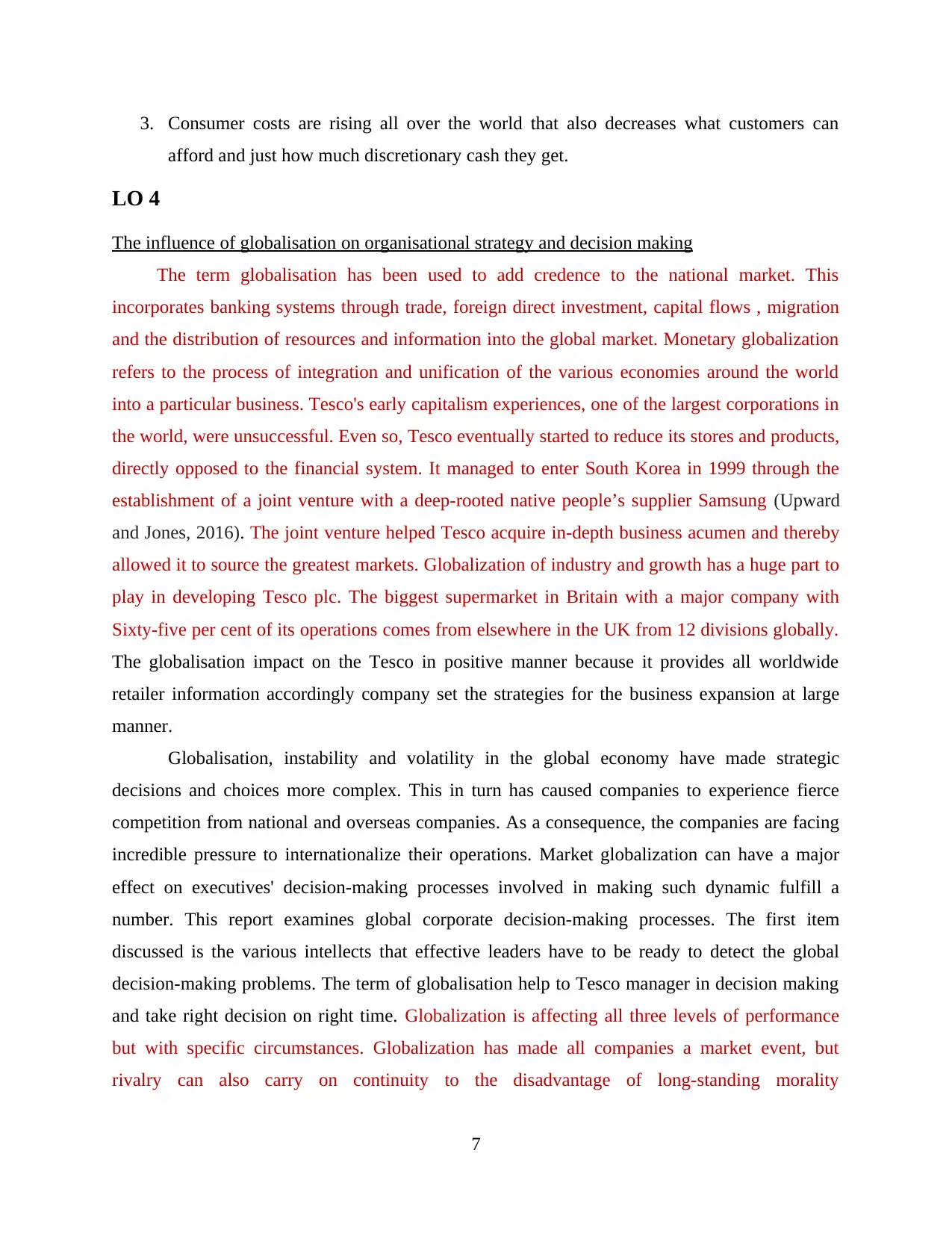
3. Consumer costs are rising all over the world that also decreases what customers can
afford and just how much discretionary cash they get.
LO 4
The influence of globalisation on organisational strategy and decision making
The term globalisation has been used to add credence to the national market. This
incorporates banking systems through trade, foreign direct investment, capital flows , migration
and the distribution of resources and information into the global market. Monetary globalization
refers to the process of integration and unification of the various economies around the world
into a particular business. Tesco's early capitalism experiences, one of the largest corporations in
the world, were unsuccessful. Even so, Tesco eventually started to reduce its stores and products,
directly opposed to the financial system. It managed to enter South Korea in 1999 through the
establishment of a joint venture with a deep-rooted native people’s supplier Samsung (Upward
and Jones, 2016). The joint venture helped Tesco acquire in-depth business acumen and thereby
allowed it to source the greatest markets. Globalization of industry and growth has a huge part to
play in developing Tesco plc. The biggest supermarket in Britain with a major company with
Sixty-five per cent of its operations comes from elsewhere in the UK from 12 divisions globally.
The globalisation impact on the Tesco in positive manner because it provides all worldwide
retailer information accordingly company set the strategies for the business expansion at large
manner.
Globalisation, instability and volatility in the global economy have made strategic
decisions and choices more complex. This in turn has caused companies to experience fierce
competition from national and overseas companies. As a consequence, the companies are facing
incredible pressure to internationalize their operations. Market globalization can have a major
effect on executives' decision-making processes involved in making such dynamic fulfill a
number. This report examines global corporate decision-making processes. The first item
discussed is the various intellects that effective leaders have to be ready to detect the global
decision-making problems. The term of globalisation help to Tesco manager in decision making
and take right decision on right time. Globalization is affecting all three levels of performance
but with specific circumstances. Globalization has made all companies a market event, but
rivalry can also carry on continuity to the disadvantage of long-standing morality
7
afford and just how much discretionary cash they get.
LO 4
The influence of globalisation on organisational strategy and decision making
The term globalisation has been used to add credence to the national market. This
incorporates banking systems through trade, foreign direct investment, capital flows , migration
and the distribution of resources and information into the global market. Monetary globalization
refers to the process of integration and unification of the various economies around the world
into a particular business. Tesco's early capitalism experiences, one of the largest corporations in
the world, were unsuccessful. Even so, Tesco eventually started to reduce its stores and products,
directly opposed to the financial system. It managed to enter South Korea in 1999 through the
establishment of a joint venture with a deep-rooted native people’s supplier Samsung (Upward
and Jones, 2016). The joint venture helped Tesco acquire in-depth business acumen and thereby
allowed it to source the greatest markets. Globalization of industry and growth has a huge part to
play in developing Tesco plc. The biggest supermarket in Britain with a major company with
Sixty-five per cent of its operations comes from elsewhere in the UK from 12 divisions globally.
The globalisation impact on the Tesco in positive manner because it provides all worldwide
retailer information accordingly company set the strategies for the business expansion at large
manner.
Globalisation, instability and volatility in the global economy have made strategic
decisions and choices more complex. This in turn has caused companies to experience fierce
competition from national and overseas companies. As a consequence, the companies are facing
incredible pressure to internationalize their operations. Market globalization can have a major
effect on executives' decision-making processes involved in making such dynamic fulfill a
number. This report examines global corporate decision-making processes. The first item
discussed is the various intellects that effective leaders have to be ready to detect the global
decision-making problems. The term of globalisation help to Tesco manager in decision making
and take right decision on right time. Globalization is affecting all three levels of performance
but with specific circumstances. Globalization has made all companies a market event, but
rivalry can also carry on continuity to the disadvantage of long-standing morality
7
⊘ This is a preview!⊘
Do you want full access?
Subscribe today to unlock all pages.

Trusted by 1+ million students worldwide
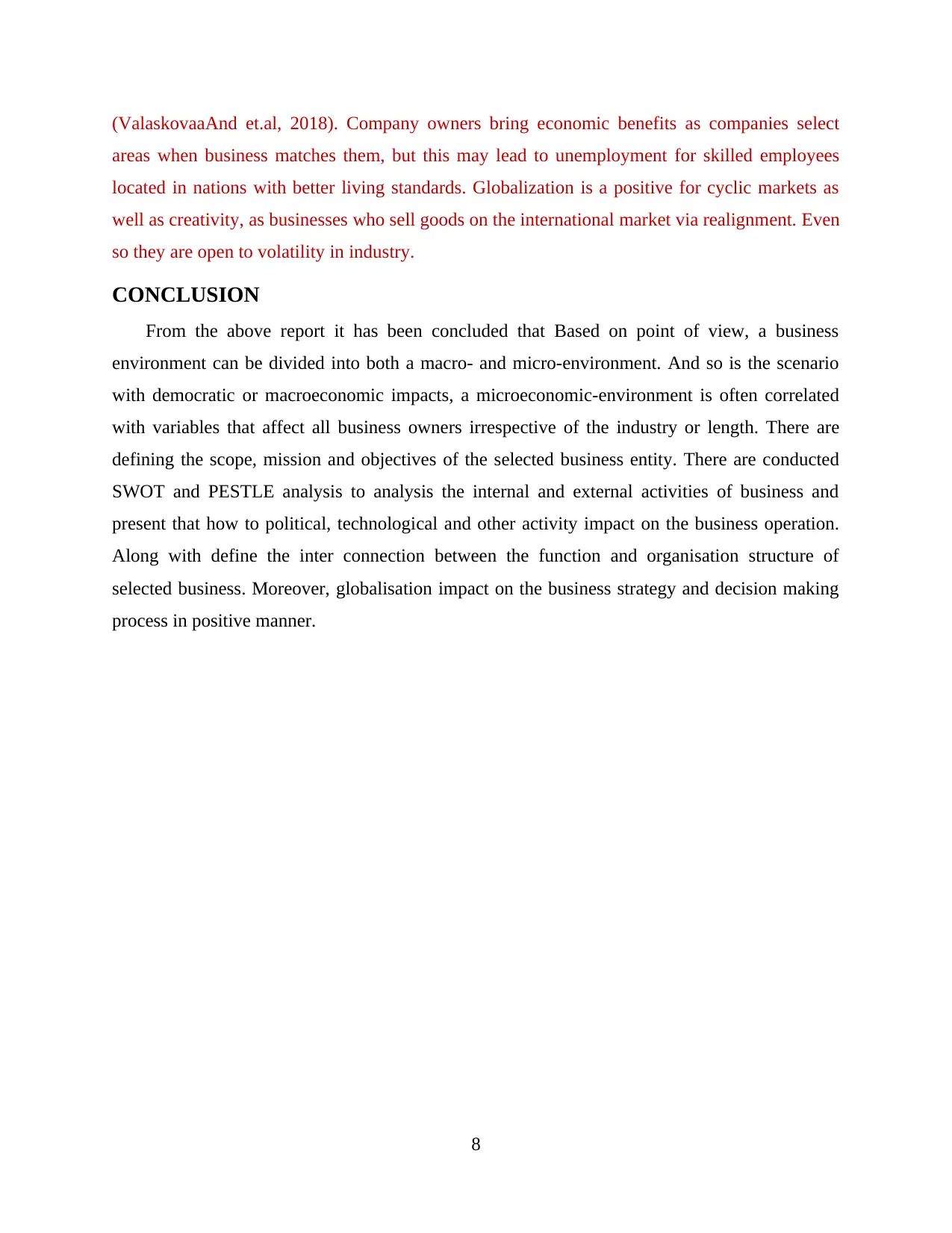
(ValaskovaaAnd et.al, 2018). Company owners bring economic benefits as companies select
areas when business matches them, but this may lead to unemployment for skilled employees
located in nations with better living standards. Globalization is a positive for cyclic markets as
well as creativity, as businesses who sell goods on the international market via realignment. Even
so they are open to volatility in industry.
CONCLUSION
From the above report it has been concluded that Based on point of view, a business
environment can be divided into both a macro- and micro-environment. And so is the scenario
with democratic or macroeconomic impacts, a microeconomic-environment is often correlated
with variables that affect all business owners irrespective of the industry or length. There are
defining the scope, mission and objectives of the selected business entity. There are conducted
SWOT and PESTLE analysis to analysis the internal and external activities of business and
present that how to political, technological and other activity impact on the business operation.
Along with define the inter connection between the function and organisation structure of
selected business. Moreover, globalisation impact on the business strategy and decision making
process in positive manner.
8
areas when business matches them, but this may lead to unemployment for skilled employees
located in nations with better living standards. Globalization is a positive for cyclic markets as
well as creativity, as businesses who sell goods on the international market via realignment. Even
so they are open to volatility in industry.
CONCLUSION
From the above report it has been concluded that Based on point of view, a business
environment can be divided into both a macro- and micro-environment. And so is the scenario
with democratic or macroeconomic impacts, a microeconomic-environment is often correlated
with variables that affect all business owners irrespective of the industry or length. There are
defining the scope, mission and objectives of the selected business entity. There are conducted
SWOT and PESTLE analysis to analysis the internal and external activities of business and
present that how to political, technological and other activity impact on the business operation.
Along with define the inter connection between the function and organisation structure of
selected business. Moreover, globalisation impact on the business strategy and decision making
process in positive manner.
8
Paraphrase This Document
Need a fresh take? Get an instant paraphrase of this document with our AI Paraphraser
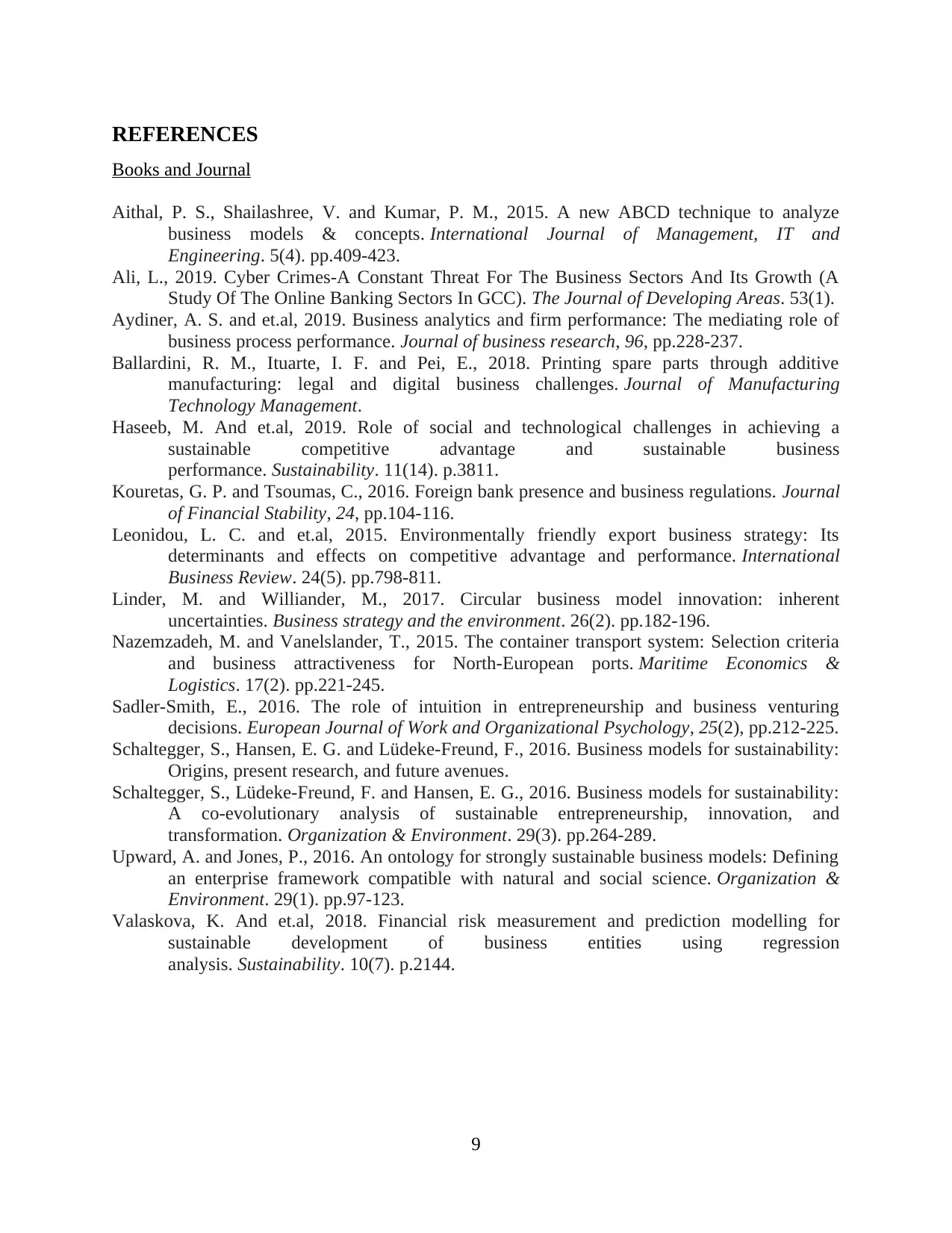
REFERENCES
Books and Journal
Aithal, P. S., Shailashree, V. and Kumar, P. M., 2015. A new ABCD technique to analyze
business models & concepts. International Journal of Management, IT and
Engineering. 5(4). pp.409-423.
Ali, L., 2019. Cyber Crimes-A Constant Threat For The Business Sectors And Its Growth (A
Study Of The Online Banking Sectors In GCC). The Journal of Developing Areas. 53(1).
Aydiner, A. S. and et.al, 2019. Business analytics and firm performance: The mediating role of
business process performance. Journal of business research, 96, pp.228-237.
Ballardini, R. M., Ituarte, I. F. and Pei, E., 2018. Printing spare parts through additive
manufacturing: legal and digital business challenges. Journal of Manufacturing
Technology Management.
Haseeb, M. And et.al, 2019. Role of social and technological challenges in achieving a
sustainable competitive advantage and sustainable business
performance. Sustainability. 11(14). p.3811.
Kouretas, G. P. and Tsoumas, C., 2016. Foreign bank presence and business regulations. Journal
of Financial Stability, 24, pp.104-116.
Leonidou, L. C. and et.al, 2015. Environmentally friendly export business strategy: Its
determinants and effects on competitive advantage and performance. International
Business Review. 24(5). pp.798-811.
Linder, M. and Williander, M., 2017. Circular business model innovation: inherent
uncertainties. Business strategy and the environment. 26(2). pp.182-196.
Nazemzadeh, M. and Vanelslander, T., 2015. The container transport system: Selection criteria
and business attractiveness for North-European ports. Maritime Economics &
Logistics. 17(2). pp.221-245.
Sadler-Smith, E., 2016. The role of intuition in entrepreneurship and business venturing
decisions. European Journal of Work and Organizational Psychology, 25(2), pp.212-225.
Schaltegger, S., Hansen, E. G. and Lüdeke-Freund, F., 2016. Business models for sustainability:
Origins, present research, and future avenues.
Schaltegger, S., Lüdeke-Freund, F. and Hansen, E. G., 2016. Business models for sustainability:
A co-evolutionary analysis of sustainable entrepreneurship, innovation, and
transformation. Organization & Environment. 29(3). pp.264-289.
Upward, A. and Jones, P., 2016. An ontology for strongly sustainable business models: Defining
an enterprise framework compatible with natural and social science. Organization &
Environment. 29(1). pp.97-123.
Valaskova, K. And et.al, 2018. Financial risk measurement and prediction modelling for
sustainable development of business entities using regression
analysis. Sustainability. 10(7). p.2144.
9
Books and Journal
Aithal, P. S., Shailashree, V. and Kumar, P. M., 2015. A new ABCD technique to analyze
business models & concepts. International Journal of Management, IT and
Engineering. 5(4). pp.409-423.
Ali, L., 2019. Cyber Crimes-A Constant Threat For The Business Sectors And Its Growth (A
Study Of The Online Banking Sectors In GCC). The Journal of Developing Areas. 53(1).
Aydiner, A. S. and et.al, 2019. Business analytics and firm performance: The mediating role of
business process performance. Journal of business research, 96, pp.228-237.
Ballardini, R. M., Ituarte, I. F. and Pei, E., 2018. Printing spare parts through additive
manufacturing: legal and digital business challenges. Journal of Manufacturing
Technology Management.
Haseeb, M. And et.al, 2019. Role of social and technological challenges in achieving a
sustainable competitive advantage and sustainable business
performance. Sustainability. 11(14). p.3811.
Kouretas, G. P. and Tsoumas, C., 2016. Foreign bank presence and business regulations. Journal
of Financial Stability, 24, pp.104-116.
Leonidou, L. C. and et.al, 2015. Environmentally friendly export business strategy: Its
determinants and effects on competitive advantage and performance. International
Business Review. 24(5). pp.798-811.
Linder, M. and Williander, M., 2017. Circular business model innovation: inherent
uncertainties. Business strategy and the environment. 26(2). pp.182-196.
Nazemzadeh, M. and Vanelslander, T., 2015. The container transport system: Selection criteria
and business attractiveness for North-European ports. Maritime Economics &
Logistics. 17(2). pp.221-245.
Sadler-Smith, E., 2016. The role of intuition in entrepreneurship and business venturing
decisions. European Journal of Work and Organizational Psychology, 25(2), pp.212-225.
Schaltegger, S., Hansen, E. G. and Lüdeke-Freund, F., 2016. Business models for sustainability:
Origins, present research, and future avenues.
Schaltegger, S., Lüdeke-Freund, F. and Hansen, E. G., 2016. Business models for sustainability:
A co-evolutionary analysis of sustainable entrepreneurship, innovation, and
transformation. Organization & Environment. 29(3). pp.264-289.
Upward, A. and Jones, P., 2016. An ontology for strongly sustainable business models: Defining
an enterprise framework compatible with natural and social science. Organization &
Environment. 29(1). pp.97-123.
Valaskova, K. And et.al, 2018. Financial risk measurement and prediction modelling for
sustainable development of business entities using regression
analysis. Sustainability. 10(7). p.2144.
9
1 out of 11
Related Documents
Your All-in-One AI-Powered Toolkit for Academic Success.
+13062052269
info@desklib.com
Available 24*7 on WhatsApp / Email
![[object Object]](/_next/static/media/star-bottom.7253800d.svg)
Unlock your academic potential
Copyright © 2020–2025 A2Z Services. All Rights Reserved. Developed and managed by ZUCOL.





